Momchil Hardalov
Post-OCR Text Correction for Bulgarian Historical Documents
Aug 31, 2024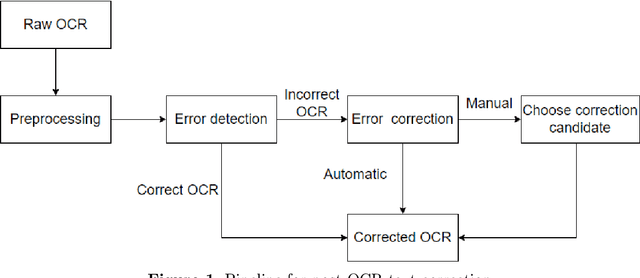



Abstract:The digitization of historical documents is crucial for preserving the cultural heritage of the society. An important step in this process is converting scanned images to text using Optical Character Recognition (OCR), which can enable further search, information extraction, etc. Unfortunately, this is a hard problem as standard OCR tools are not tailored to deal with historical orthography as well as with challenging layouts. Thus, it is standard to apply an additional text correction step on the OCR output when dealing with such documents. In this work, we focus on Bulgarian, and we create the first benchmark dataset for evaluating the OCR text correction for historical Bulgarian documents written in the first standardized Bulgarian orthography: the Drinov orthography from the 19th century. We further develop a method for automatically generating synthetic data in this orthography, as well as in the subsequent Ivanchev orthography, by leveraging vast amounts of contemporary literature Bulgarian texts. We then use state-of-the-art LLMs and encoder-decoder framework which we augment with diagonal attention loss and copy and coverage mechanisms to improve the post-OCR text correction. The proposed method reduces the errors introduced during recognition and improves the quality of the documents by 25\%, which is an increase of 16\% compared to the state-of-the-art on the ICDAR 2019 Bulgarian dataset. We release our data and code at \url{https://github.com/angelbeshirov/post-ocr-text-correction}.}
DEM: Distribution Edited Model for Training with Mixed Data Distributions
Jun 21, 2024



Abstract:Training with mixed data distributions is a common and important part of creating multi-task and instruction-following models. The diversity of the data distributions and cost of joint training makes the optimization procedure extremely challenging. Data mixing methods partially address this problem, albeit having a sub-optimal performance across data sources and require multiple expensive training runs. In this paper, we propose a simple and efficient alternative for better optimization of the data sources by combining models individually trained on each data source with the base model using basic element-wise vector operations. The resulting model, namely Distribution Edited Model (DEM), is 11x cheaper than standard data mixing and outperforms strong baselines on a variety of benchmarks, yielding up to 6.2% improvement on MMLU, 11.5% on BBH, 16.1% on DROP, and 9.3% on HELM with models of size 3B to 13B. Notably, DEM does not require full re-training when modifying a single data-source, thus making it very flexible and scalable for training with diverse data sources.
Factual Confidence of LLMs: on Reliability and Robustness of Current Estimators
Jun 19, 2024Abstract:Large Language Models (LLMs) tend to be unreliable in the factuality of their answers. To address this problem, NLP researchers have proposed a range of techniques to estimate LLM's confidence over facts. However, due to the lack of a systematic comparison, it is not clear how the different methods compare to one another. To fill this gap, we present a survey and empirical comparison of estimators of factual confidence. We define an experimental framework allowing for fair comparison, covering both fact-verification and question answering. Our experiments across a series of LLMs indicate that trained hidden-state probes provide the most reliable confidence estimates, albeit at the expense of requiring access to weights and training data. We also conduct a deeper assessment of factual confidence by measuring the consistency of model behavior under meaning-preserving variations in the input. We find that the confidence of LLMs is often unstable across semantically equivalent inputs, suggesting that there is much room for improvement of the stability of models' parametric knowledge. Our code is available at (https://github.com/amazon-science/factual-confidence-of-llms).
bgGLUE: A Bulgarian General Language Understanding Evaluation Benchmark
Jun 07, 2023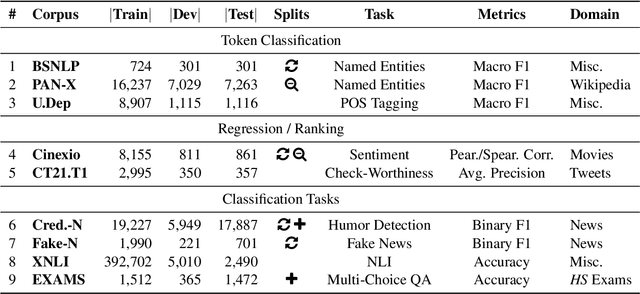
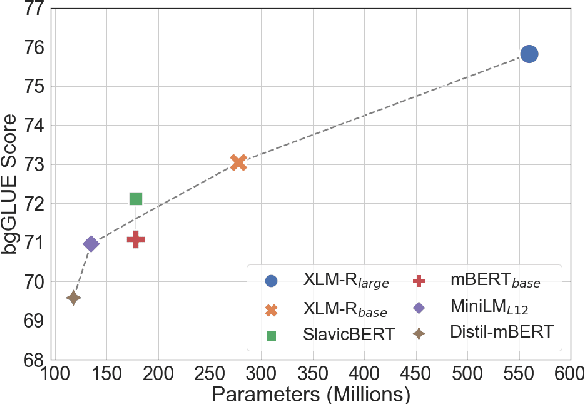
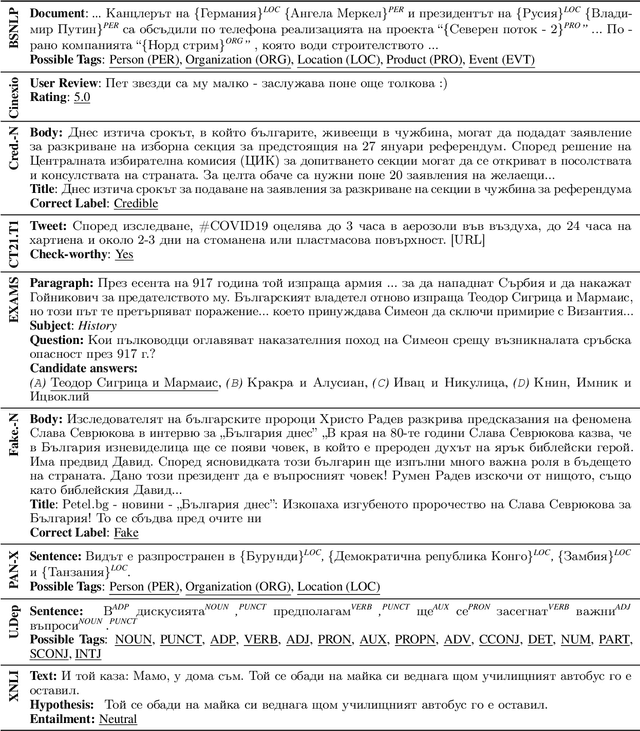
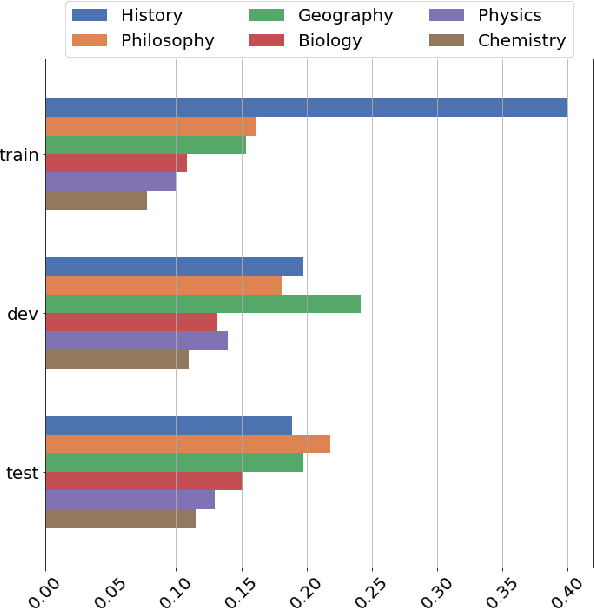
Abstract:We present bgGLUE(Bulgarian General Language Understanding Evaluation), a benchmark for evaluating language models on Natural Language Understanding (NLU) tasks in Bulgarian. Our benchmark includes NLU tasks targeting a variety of NLP problems (e.g., natural language inference, fact-checking, named entity recognition, sentiment analysis, question answering, etc.) and machine learning tasks (sequence labeling, document-level classification, and regression). We run the first systematic evaluation of pre-trained language models for Bulgarian, comparing and contrasting results across the nine tasks in the benchmark. The evaluation results show strong performance on sequence labeling tasks, but there is a lot of room for improvement for tasks that require more complex reasoning. We make bgGLUE publicly available together with the fine-tuning and the evaluation code, as well as a public leaderboard at https://bgglue.github.io/, and we hope that it will enable further advancements in developing NLU models for Bulgarian.
* Accepted to ACL 2023 (Main Conference)
Diable: Efficient Dialogue State Tracking as Operations on Tables
May 26, 2023Abstract:Sequence-to-sequence state-of-the-art systems for dialogue state tracking (DST) use the full dialogue history as input, represent the current state as a list with all the slots, and generate the entire state from scratch at each dialogue turn. This approach is inefficient, especially when the number of slots is large and the conversation is long. In this paper, we propose Diable, a new task formalisation that simplifies the design and implementation of efficient DST systems and allows one to easily plug and play large language models. We represent the dialogue state as a table and formalise DST as a table manipulation task. At each turn, the system updates the previous state by generating table operations based on the dialogue context. Extensive experimentation on the MultiWoz datasets demonstrates that Diable (i) outperforms strong efficient DST baselines, (ii) is 2.4x more time efficient than current state-of-the-art methods while retaining competitive Joint Goal Accuracy, and (iii) is robust to noisy data annotations due to the table operations approach.
CrowdChecked: Detecting Previously Fact-Checked Claims in Social Media
Oct 10, 2022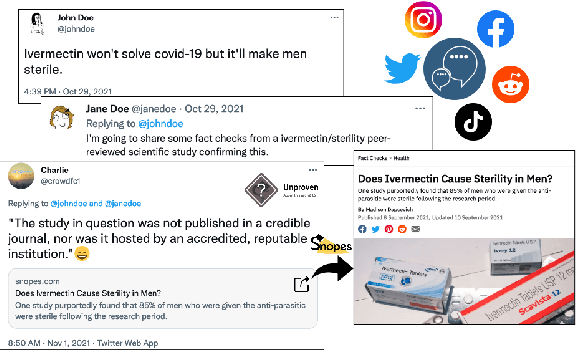

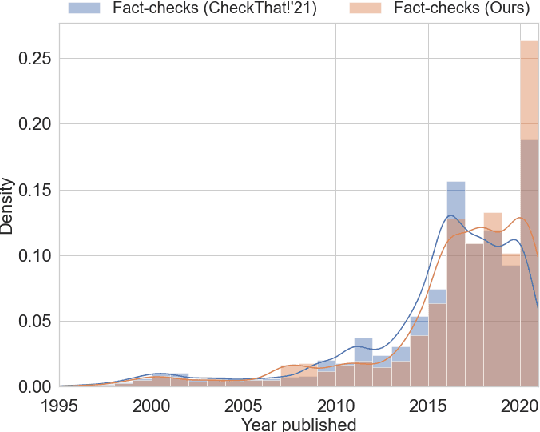
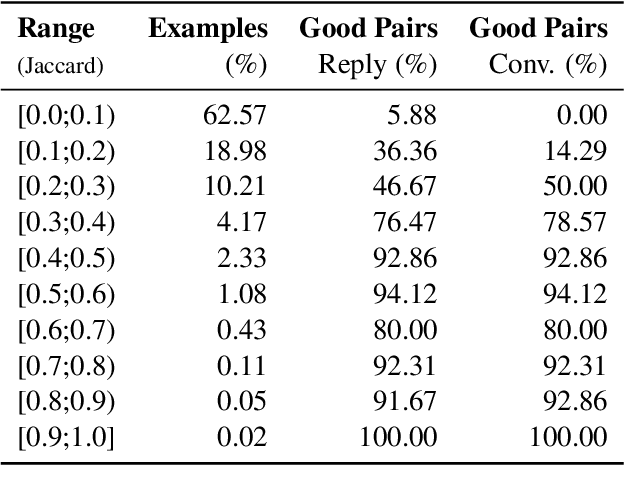
Abstract:While there has been substantial progress in developing systems to automate fact-checking, they still lack credibility in the eyes of the users. Thus, an interesting approach has emerged: to perform automatic fact-checking by verifying whether an input claim has been previously fact-checked by professional fact-checkers and to return back an article that explains their decision. This is a sensible approach as people trust manual fact-checking, and as many claims are repeated multiple times. Yet, a major issue when building such systems is the small number of known tweet--verifying article pairs available for training. Here, we aim to bridge this gap by making use of crowd fact-checking, i.e., mining claims in social media for which users have responded with a link to a fact-checking article. In particular, we mine a large-scale collection of 330,000 tweets paired with a corresponding fact-checking article. We further propose an end-to-end framework to learn from this noisy data based on modified self-adaptive training, in a distant supervision scenario. Our experiments on the CLEF'21 CheckThat! test set show improvements over the state of the art by two points absolute. Our code and datasets are available at https://github.com/mhardalov/crowdchecked-claims
* Accepted to AACL-IJCNLP 2022 (Main Conference)
Leaf: Multiple-Choice Question Generation
Jan 22, 2022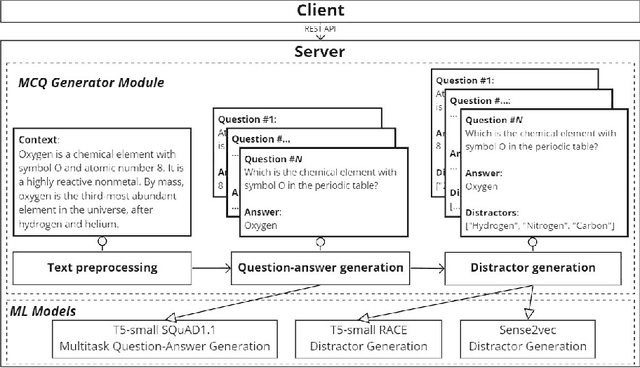
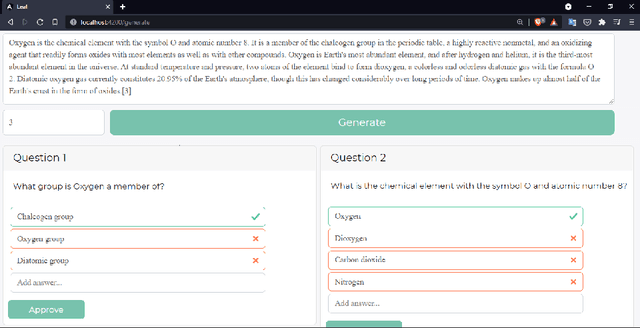
Abstract:Testing with quiz questions has proven to be an effective way to assess and improve the educational process. However, manually creating quizzes is tedious and time-consuming. To address this challenge, we present Leaf, a system for generating multiple-choice questions from factual text. In addition to being very well suited for the classroom, Leaf could also be used in an industrial setting, e.g., to facilitate onboarding and knowledge sharing, or as a component of chatbots, question answering systems, or Massive Open Online Courses (MOOCs). The code and the demo are available on https://github.com/KristiyanVachev/Leaf-Question-Generation.
SUper Team at SemEval-2016 Task 3: Building a feature-rich system for community question answering
Sep 26, 2021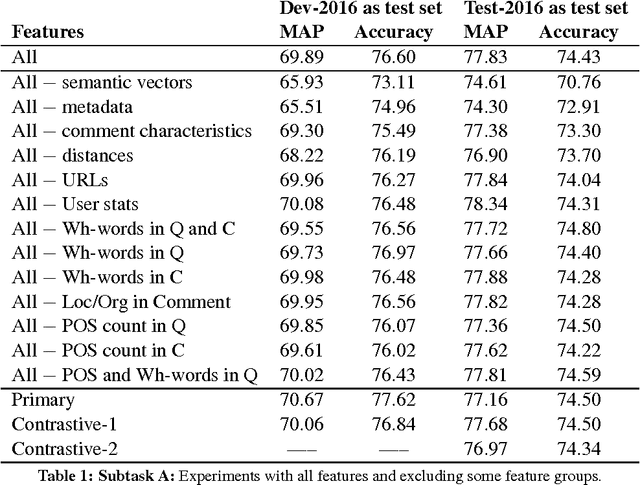
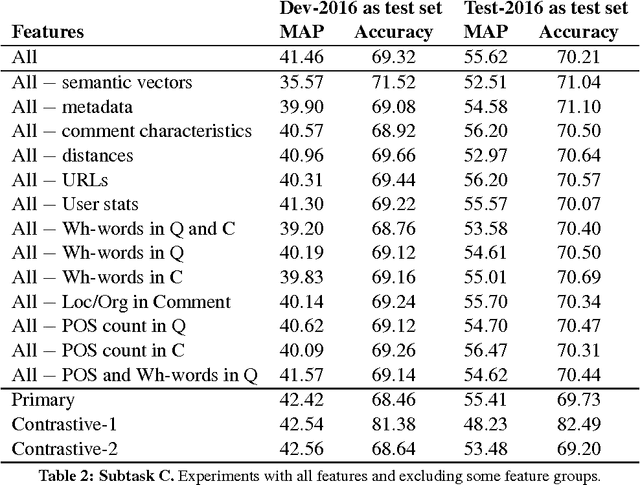

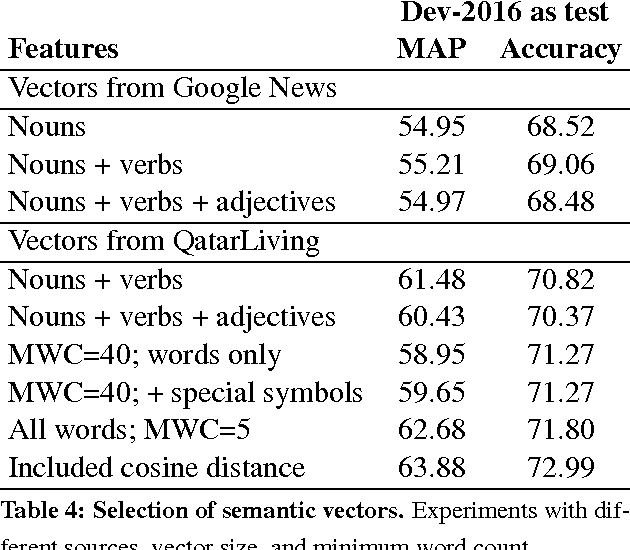
Abstract:We present the system we built for participating in SemEval-2016 Task 3 on Community Question Answering. We achieved the best results on subtask C, and strong results on subtasks A and B, by combining a rich set of various types of features: semantic, lexical, metadata, and user-related. The most important group turned out to be the metadata for the question and for the comment, semantic vectors trained on QatarLiving data and similarities between the question and the comment for subtasks A and C, and between the original and the related question for Subtask B.
* community question answering, question-question similarity, question-comment similarity, answer reranking
Few-Shot Cross-Lingual Stance Detection with Sentiment-Based Pre-Training
Sep 13, 2021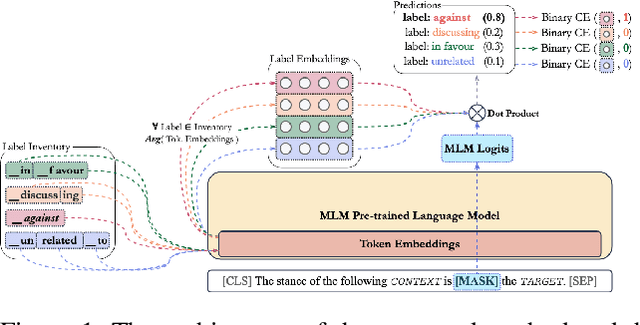
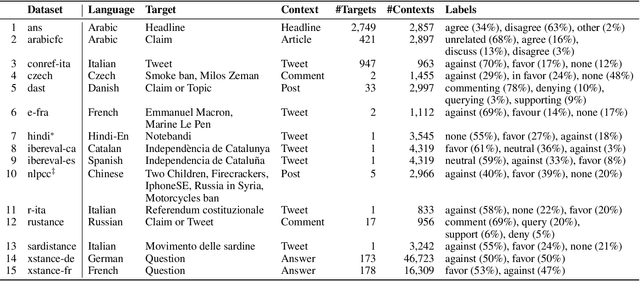
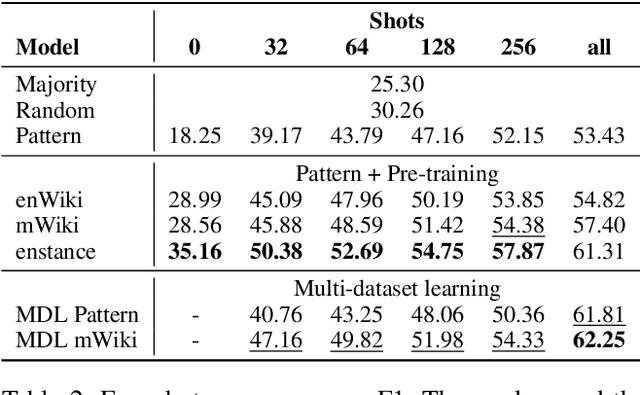
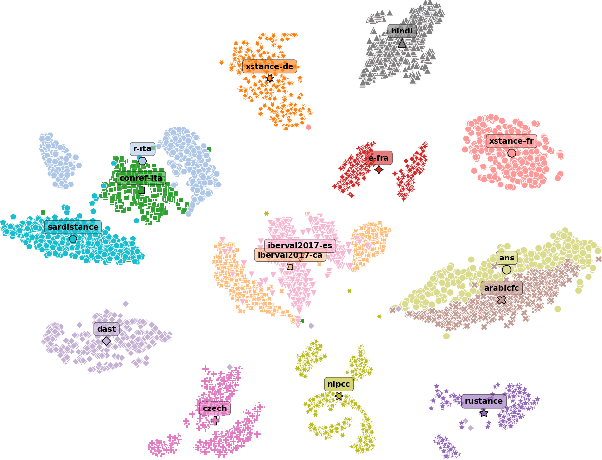
Abstract:The goal of stance detection is to determine the viewpoint expressed in a piece of text towards a target. These viewpoints or contexts are often expressed in many different languages depending on the user and the platform, which can be a local news outlet, a social media platform, a news forum, etc. Most research in stance detection, however, has been limited to working with a single language and on a few limited targets, with little work on cross-lingual stance detection. Moreover, non-English sources of labelled data are often scarce and present additional challenges. Recently, large multilingual language models have substantially improved the performance on many non-English tasks, especially such with limited numbers of examples. This highlights the importance of model pre-training and its ability to learn from few examples. In this paper, we present the most comprehensive study of cross-lingual stance detection to date: we experiment with 15 diverse datasets in 12 languages from 6 language families, and with 6 low-resource evaluation settings each. For our experiments, we build on pattern-exploiting training, proposing the addition of a novel label encoder to simplify the verbalisation procedure. We further propose sentiment-based generation of stance data for pre-training, which shows sizeable improvement of more than 6% F1 absolute in low-shot settings compared to several strong baselines.
Generating Answer Candidates for Quizzes and Answer-Aware Question Generators
Aug 29, 2021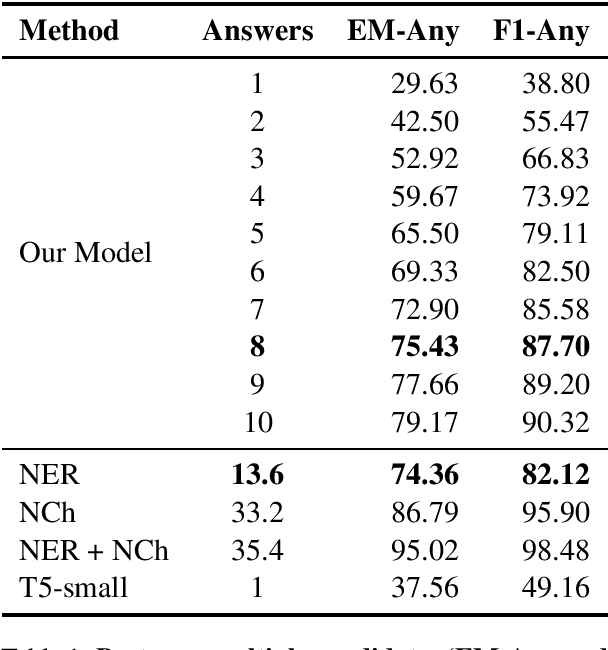
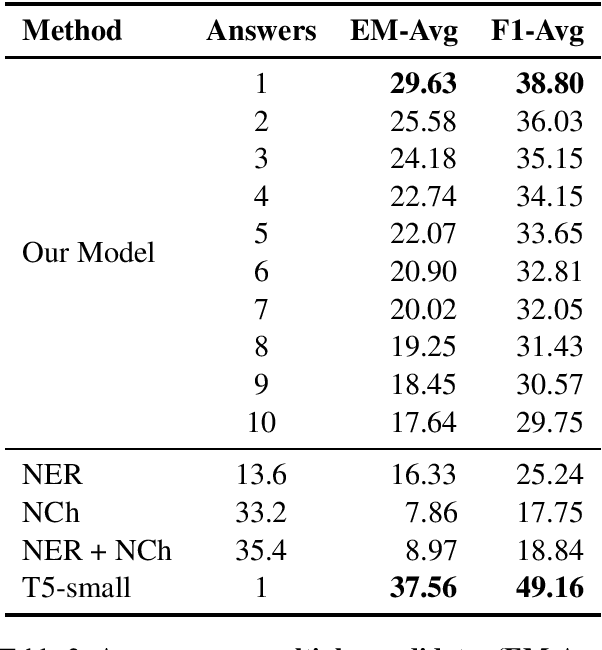
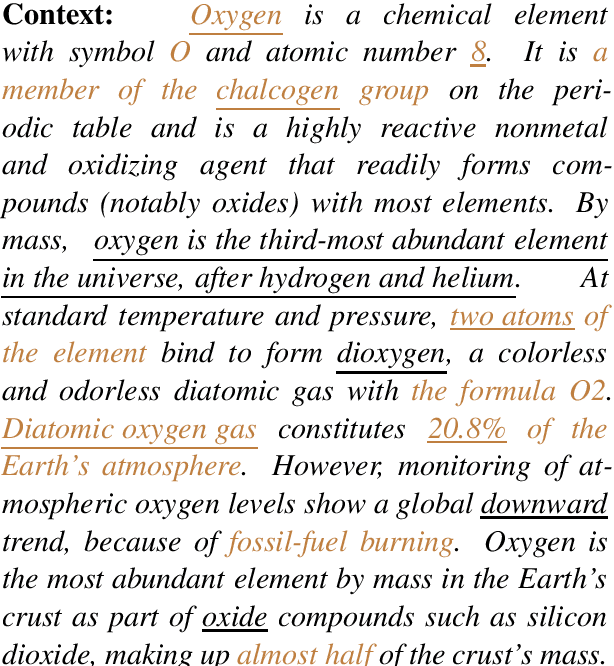
Abstract:In education, open-ended quiz questions have become an important tool for assessing the knowledge of students. Yet, manually preparing such questions is a tedious task, and thus automatic question generation has been proposed as a possible alternative. So far, the vast majority of research has focused on generating the question text, relying on question answering datasets with readily picked answers, and the problem of how to come up with answer candidates in the first place has been largely ignored. Here, we aim to bridge this gap. In particular, we propose a model that can generate a specified number of answer candidates for a given passage of text, which can then be used by instructors to write questions manually or can be passed as an input to automatic answer-aware question generators. Our experiments show that our proposed answer candidate generation model outperforms several baselines.
* answer generation, question generation, answer-aware question generation, quiz questions, question answering
 Add to Chrome
Add to Chrome Add to Firefox
Add to Firefox Add to Edge
Add to Edge